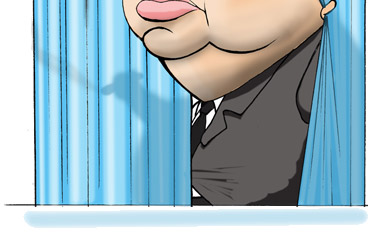
nlike the other directors in our Hall of Fame, Alfred Hitchcock (August 13, 1899 – April 29, 1980) actually has his own theme song…so please hum, if you will, the strains to Charles Gounod's "Funeral March of a Marionette," a.k.a. the theme to "Alfred Hitchcock Presents," as we begin our discussion of the portly genius whose name will likely always remain synonymous with "suspense."
Hitchcock was born and raised in Leytonstone, in East London, England. His childhood, he said on several occasions, was a lonely one, and his parents had rather unique views on childrearing. Hitchcock once said that, after an incident of acting up, his father sent him to the local police station carrying a note; when he presented the police officer on duty with the note, he was locked in a cell for just long enough to be scared out of his wits. (Possibly not coincidentally, Hitchcock reportedly never got a driver's license because he felt that if he couldn't drive, then he couldn't be pulled over by the police.)
After working on 11 silent films, Hitchcock entered the world of the "talkies" with 1929's "Blackmail," which was, in fact, the first "talkie" to emerge from Britain. It wasn't until 1934's "The Man Who Knew Too Much," however, that Hitchcock's reputation as a director truly began to blossom. From there, a steady stream of classics – among them, "The 39 Steps," "Sabotage," and "The Lady Vanishes" – resulted in Hollywood – or, specifically, producer David O. Selznick – taking notice and inviting Hitchcock to make pictures in the United States.
Given that Hitchcock's first film for Selznick, "Rebecca," proceeded to win the Academy Award for Best Picture, and his second – "Foreign Correspondent" – received a nomination in the same category the following year, you'd think that the producer would've been pleased. In fact, however, the two regularly clashed; Selznick once referred to the director's style as "goddamn jigsaw cutting," and Hitchcock's creative process was regularly stifled by Selznick's desire to see his visions of the films come to fruition over Hitchcock's. As a result, Selznick came to regularly "loan out" Hitchcock to other studios, as much to avoid the hassle of working with him as anything.
Hitchcock's directorial style was one filled with certain hallmarks. As noted, he was the king of suspense, preferring to provide the viewer with information of which the characters themselves are unaware. He also enjoyed the use of something he called "the MacGuffin," which is generally defined as a plot device that motivates a film's characters and advances the story, but has little other relevance. Most importantly, however, Hitchcock enjoying trying new things, like the famous zoom shot in "Vertigo," which has been replicated by many a director (most notably Steven Spielberg in "Jaws"); he also produced the effect that his film "Rope" was filmed in a single take by having dark objects fill the entire screen on several occasions, each for just long enough to hide the cutting of the film. And, lest we forget, "Psycho" was sufficiently impressive that Gus Van Sant did a remake of the film that, minus a few touches to unnecessarily modernize the film, was a shot-for-shot reproduction of Hitchcock's original. Amazingly, however, Hitchcock never won a Best Director Oscar.
 Hitchcock was known for his tendency to utilize major landmarks within his motion pictures; as a result, there are many buildings and monuments inextricably linked to his films, such as the British Museum ("Blackmail"), Mount Rushmore ("North by Northwest"), and the Statue of Liberty ("Saboteur"). He's probably more known, however, for the fact that he can be briefly found onscreen in almost all of his films, like a celluloid version of the "Where's Waldo?" books; even in "Lifeboat," which took place in decidedly cramped quarters, he can be seen in a newspaper advertisement for a weight-loss product.
Hitchcock was known for his tendency to utilize major landmarks within his motion pictures; as a result, there are many buildings and monuments inextricably linked to his films, such as the British Museum ("Blackmail"), Mount Rushmore ("North by Northwest"), and the Statue of Liberty ("Saboteur"). He's probably more known, however, for the fact that he can be briefly found onscreen in almost all of his films, like a celluloid version of the "Where's Waldo?" books; even in "Lifeboat," which took place in decidedly cramped quarters, he can be seen in a newspaper advertisement for a weight-loss product.
In addition to his film work, Hitchcock became a television icon as well, courtesy of the aforementioned anthology series, "Alfred Hitchcock Presents." (Some may recall that the show was also revived by NBC in the '80s.) He also loaned out his name to a magazine, a series of books for teens ("Alfred Hitchcock and the Three Investigators," where he served as a mentor for a trio of young detectives), and many anthologies of short stories. And, yes, "loaned" is the appropriate word; although he purportedly wrote introductions for the anthologies, it's well-documented that all Hitchcock really did was collect a check for the use of his name. (Nice work, Sir Alfred.)
Given that he's identifiable by as little as his silhouette – and like the bit about the theme song in the opening paragraph, how many directors can say that? – it's fair to say that Alfred Hitchcock's contributions to film will be remembered for the long haul.

"The 39 Steps"
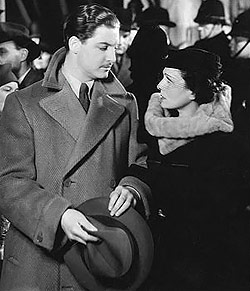 Most critics agree that this adaptation of John Buchan's novel is the first of Hitchcock's true classics; as recently as 2004, Total Film declared it to be the 21st greatest British film of all time. It's also the first of his innocent-man-on-the-run films.
Most critics agree that this adaptation of John Buchan's novel is the first of Hitchcock's true classics; as recently as 2004, Total Film declared it to be the 21st greatest British film of all time. It's also the first of his innocent-man-on-the-run films.
"Rear Window"
Jimmy Stewart is a voyeur…well, not by nature. It's more of a circumstantial thing; he's laid up in a cast, stuck in a wheelchair, and since he's not getting out the house much, he ends up looking through his telescope rather a lot. Sadly, there are a lot of kids reading this who are only at this very moment realizing that a "Simpsons" episode once parodied the movie. The show's writers are good…but they're not Hitchcock good.
"Vertigo"
Jimmy Stewart returns, this time as a guy who's got a major fear of heights, one that's emphasized to the viewer via that kick-ass zoom technique of Hitchcock's. This, more often than any others, tends to be the film selected as the answer to the question, "If you have to pick one Hitchcock film to see, which one should it be?" It's also probably been parodied and referenced more than any other Hitchcock film.
"Psycho"
 It's not the best film Hitchcock did – not by a damned sight – but it's one for which he'll always be remembered…if only because he made showers seem like the scariest possible way to get oneself clean. It also has that score by Bernard Hermann. (Cue the screeching violins!) Of course, Anthony Perkins ended up typecast as a nut job for the rest of his career, but you can't win 'em all.
It's not the best film Hitchcock did – not by a damned sight – but it's one for which he'll always be remembered…if only because he made showers seem like the scariest possible way to get oneself clean. It also has that score by Bernard Hermann. (Cue the screeching violins!) Of course, Anthony Perkins ended up typecast as a nut job for the rest of his career, but you can't win 'em all.
How do you mistake Cary Grant for someone else? He's Cary Grant, for God's sake! Despite this, it's still a great film, as much because of Grant's onscreen charisma as Hitchcock's directing. And has anyone ever depicted drunk driving more realistically than it's done in this film? You're almost on the verge of laughing at Grant's expressions, but anyone who's ever gotten behind the wheel after one too many drinks will shudder at the accuracy of Hitchcock's visual representation of the experience.

"Marnie"
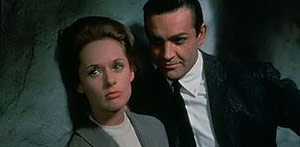 Tippi Hedren returns to the world of Hitchcock after her role in "The Birds," teaming with Sean Connery for this film that's probably the favorite of many a psychoanalyst. Audiences no doubt balked at the heavy subject matter of the film – Hedren has major psychological issues, and Connery tries to help her work through them – but many argue that the film was ahead of its time. They're right; if released now, it probably still wouldn't have topped the box office, but the art house theaters would be packed for every last showing.
Tippi Hedren returns to the world of Hitchcock after her role in "The Birds," teaming with Sean Connery for this film that's probably the favorite of many a psychoanalyst. Audiences no doubt balked at the heavy subject matter of the film – Hedren has major psychological issues, and Connery tries to help her work through them – but many argue that the film was ahead of its time. They're right; if released now, it probably still wouldn't have topped the box office, but the art house theaters would be packed for every last showing.

"Topaz"
Based on a Leon Uris novel, the film was a box office flop, which can be attributed partially to the lack of big names…well, big in the US, anyway; there were plenty of actors who were reportedly very big in France. Also, Universal forced Hitchcock to use an ending that he didn't like.

![]() I don't know what they mean when they talk about 'Hollywood' pictures. I say, 'Where are they conceived?' Look at this room – you can't see out the windows. We might just as well be in a hotel room in London, or anywhere you like. So here is where we get it down on paper. Now where do we go? We go on location, perhaps; and then where do we work? We're inside on a stage, the big doors are closed, and we're down in a coal mine: we don't know what the weather is like outside. Again we don't know where we are – only within our film, within the thing we're making. That's why it's such nonsense to talk about locale. 'Hollywood.' That doesn't mean anything to me. If you say, 'Why do you like working in Hollywood?' I would say, because I can get home at six o'clock for dinner.
I don't know what they mean when they talk about 'Hollywood' pictures. I say, 'Where are they conceived?' Look at this room – you can't see out the windows. We might just as well be in a hotel room in London, or anywhere you like. So here is where we get it down on paper. Now where do we go? We go on location, perhaps; and then where do we work? We're inside on a stage, the big doors are closed, and we're down in a coal mine: we don't know what the weather is like outside. Again we don't know where we are – only within our film, within the thing we're making. That's why it's such nonsense to talk about locale. 'Hollywood.' That doesn't mean anything to me. If you say, 'Why do you like working in Hollywood?' I would say, because I can get home at six o'clock for dinner.![]() (The Cinema of Alfred Hitchcock, Peter Bogdanovich)
(The Cinema of Alfred Hitchcock, Peter Bogdanovich)
![]() You see modern novels, psychological novels, with frank characterizations and very good psychology, but there has been a tendency, with the novel and with a lot of stage plays, to abandon story. They don't tell enough story or plot. For a motion picture, we do need quite an amount of story.
You see modern novels, psychological novels, with frank characterizations and very good psychology, but there has been a tendency, with the novel and with a lot of stage plays, to abandon story. They don't tell enough story or plot. For a motion picture, we do need quite an amount of story.![]()
![]() Violence on the screen increases violence in people only if those people already have sick minds. I once read somewhere that a man admitted killing three women and he said he had killed the third woman after having seen 'Psycho.' Well, I wanted to ask him what movie he had seen before he killed the second woman. And then we'd ban that movie, don't you see? And then if we found out that he'd had a glass of milk before he killed the first woman, why then we'd have to outlaw milk, too, wouldn't we? At a screening of 'Psycho,' a young boy came up to me – he was about nine or ten – and he said to me, 'What did you use for blood – chicken blood?' And I said, 'No, I used chocolate sauce.' And he said, 'Thank you.' The point is that he said, 'What did you use?' He knew it was a movie, that it was pretend.
Violence on the screen increases violence in people only if those people already have sick minds. I once read somewhere that a man admitted killing three women and he said he had killed the third woman after having seen 'Psycho.' Well, I wanted to ask him what movie he had seen before he killed the second woman. And then we'd ban that movie, don't you see? And then if we found out that he'd had a glass of milk before he killed the first woman, why then we'd have to outlaw milk, too, wouldn't we? At a screening of 'Psycho,' a young boy came up to me – he was about nine or ten – and he said to me, 'What did you use for blood – chicken blood?' And I said, 'No, I used chocolate sauce.' And he said, 'Thank you.' The point is that he said, 'What did you use?' He knew it was a movie, that it was pretend.![]() (The New York Times, H.E.F. Donahue)
(The New York Times, H.E.F. Donahue)
![]() One of television's great contributions is that it brought murder back into the home, where it belongs.
One of television's great contributions is that it brought murder back into the home, where it belongs.![]() (National Observer)
(National Observer)
![]() I am a typed director. If I made 'Cinderella,' the audience would immediately be looking for a body in the coach.
I am a typed director. If I made 'Cinderella,' the audience would immediately be looking for a body in the coach.![]() (Newsweek)
(Newsweek)
![]() You store up an idea and you put it away and one day it will come out. In a picture like 'North by Northwest,' I waited around 15 years to put Mount Rushmore on the screen. Unfortunately, it doesn't always work out. For example, the Department of Interiors step in and say, 'You mustn't have any character climbing over the faces of the presidents.' You say, 'Why not?' They say, 'Because this is the shrine of democracy. You must only have your characters climbing between the heads.' I was defeated, because I had a lovely image of Cary Grant sliding down Lincoln's nose and then hiding in the nostril, reduced to having a sneezing fit. I was never allowed to do it.
You store up an idea and you put it away and one day it will come out. In a picture like 'North by Northwest,' I waited around 15 years to put Mount Rushmore on the screen. Unfortunately, it doesn't always work out. For example, the Department of Interiors step in and say, 'You mustn't have any character climbing over the faces of the presidents.' You say, 'Why not?' They say, 'Because this is the shrine of democracy. You must only have your characters climbing between the heads.' I was defeated, because I had a lovely image of Cary Grant sliding down Lincoln's nose and then hiding in the nostril, reduced to having a sneezing fit. I was never allowed to do it.![]()

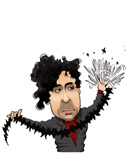 Tim Burton Tim Burton |
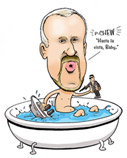 James Cameron James Cameron |
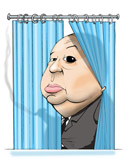 Alfred Hitchcock Alfred Hitchcock |
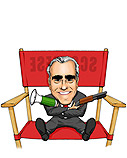 Martin Scorsese Martin Scorsese |
 Steven Spielberg Steven Spielberg |
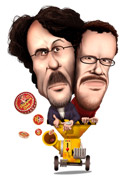 Joel & Ethan Coen Joel & Ethan Coen |
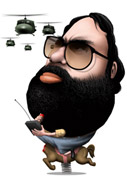 Francis Ford Coppola Francis Ford Coppola |
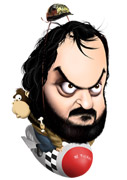 Stanley Kubrick Stanley Kubrick |
 John Landis John Landis |
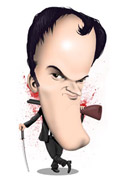 Quentin Tarantino Quentin Tarantino |
You can follow us on Twitter and Facebook for content updates. Also, sign up for our email list for weekly updates and check us out on Google+ as well.


